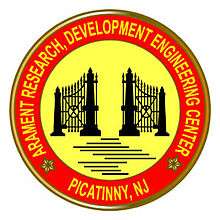United States Army Armament Research, Development and Engineering Center
| U.S. Army Armament Research, Development and Engineering Center | |
|---|---|
 | |
| Active | 1977–present[1] |
| Country | United States |
| Branch | Army |
| Type | Research and Development |
| Size |
More than 3,000 people[2] 4 Locations: Picatinny Arsenal, N.J.; Watervliet, N.Y.; Rock Island, Ill.; and Aberdeen Proving Ground, Md. |
| Garrison/HQ | Picatinny Arsenal, New Jersey |
The United States Army Armament Research, Development and Engineering Center (ARDEC), headquartered at the Picatinny Arsenal in New Jersey, is the US Army's primary research and development arm for armament and munitions systems. Besides Picatinny, ARDEC has four other research facilities, including Benét Laboratories.[3] ARDEC works to develop more advanced weapons using technologies such as microwaves, lasers and nanotechnology.
ARDEC is the R&D center for armaments used by the U.S. Army, Special Operations Command, and other organizations. It is one of the specialized research, development, and engineering centers within the U.S. Army Materiel Command. ARDEC’s purpose is to provide battlefield supremacy for U.S. troops through “overmatch capabilities.” Over the past 10 years, ARDEC has developed and released more than 20 products that have provided U.S. troops with “world’s best” capabilities, compared with products from foreign military and other U.S. defense organizations.[4]
ARDEC is the lead research, development and engineering of systems solutions to arm those who defend the nation against all current and future threats, both at home and abroad.[2] ARDEC is broken into a number of directorates such as "Weapons Systems and Technology Directorate" and "Munitions Systems and Technology Directorate".[5]
History
ARDEC traces its history to the creation of the U.S. Army Armament Research and Development Center (ARRADCOM) in 1977. Their mission was to create new and improve old weapons and munitions. Among their early work was modelling of the M1 Abrams tank.
In 1983, ARRADCOM's original mission was handed to the U.S. Army Armament, Munitions and Chemical Command (AMCCOM) at Rock Island Arsenal. However, the original weapons and munitions R&D mission remained at Picatinny after being renamed the U.S. Army Armament Research and Development Center (ARDC). In 1986, a further reorganization of all of the Army's R&D centers caused ARDC to become ARDEC. This name was retained when the group was transferred again to the Tank-automotive and Armament Command (TACOM) in 1994, and again to the Research, Development and Engineering Command (RDECOM) in 2003.
Among the many systems ARDEC worked on over its history is the Patriot missile, the fire control systems and the ammunition for the M2 Bradley, the M1 Abrams, and the M712 Copperhead anti-tank artillery missile. More recently, ARDEC has worked on bunker defeat munitions, the XM107 sniper rifle, the M919 round for the M242 Bushmaster, the M830 HEAT munition, the M211 and M212 countermeasure flares, the M4 carbine, and many other systems.[6]
Efforts to diversify ARDEC’s revenue stream have led to a growth in non-Army revenue from about $60 million in FY 2001 to $140 million in FY07. Overall revenue has increased from approximately $600 million in FY 2001 to around $1.2 billion in FY 2007. Designated as the benchmark for the Army in technology transfer, ARDEC has had since FY 2005 approximately 75 percent of its technology projects transition from research into customer funded development.
ARDEC has received awards and recognition based on customer satisfaction and perceived value including Value Engineering Accomplishments of Merit. Over the past five years, ARDEC has won 13 of the Army’s “10 Greatest Inventions of the Year” awards. Additionally, ARDEC has won the “Army Research and Development Lab of the Year” award for two of the last four years.
See also
References
- ↑ "ARDEC: History". Archived from the original on 2006-12-10. Retrieved 2007-02-13.
- 1 2 ARDEC@Picatinny
- ↑ ARDEC: Locations
- ↑ NIST National Institute of Standards and Technology
- ↑ ARDEC: Organization
- ↑ "A Brief History". ARDEC.
Coordinates: 40°57′34″N 74°31′40″W / 40.95953°N 74.52774°W